Samsung Galaxy S 2 (International) Review - The Best, Redefined
by Brian Klug & Anand Lal Shimpi on September 11, 2011 11:06 AM EST- Posted in
- Smartphones
- Samsung
- Galaxy S II
- Exynos
- Mobile
The other part of the story is Samsung’s mobile Digital Natural Image engine, or mDNIe, profile set on the SGS2. Numerous people have noticed that under Display -> Background Effect, lurks a page with a sample image and three presets - Dynamic, Standard, and Movie.
On previous Galaxy S devices there was a box in the camera app marked ‘outdoor viewing’ which increased brightness and contrast. I always wondered how that worked, and the answer is through mDNIe profiles. Inside /system/etc/ are a bunch of files prefixed with ‘mdnie_tune’ and then some more text, for example ‘mdnie_tune_camera_outdoor_mode’ and ‘mdnie_tune_standard_mode’. Of course, these are how the various settings are defined, and there are a bunch of them.
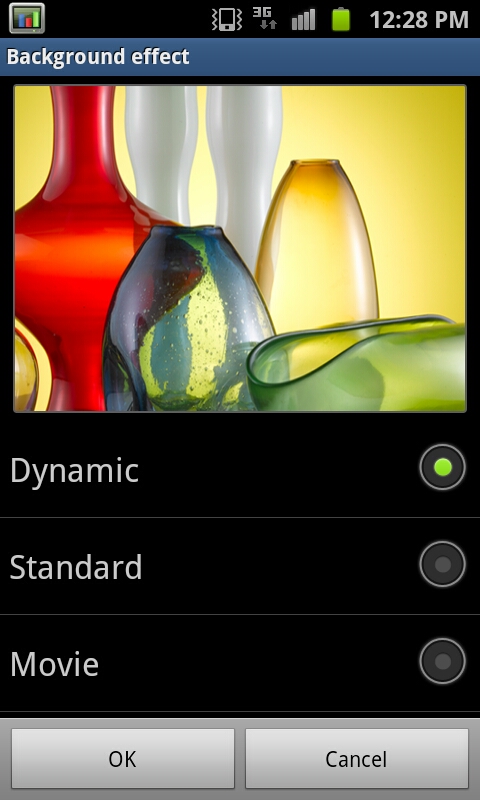
Inside are settings which control sharpening, saturation, and other things which are governed by mDNIe. For example, the mdnie_tune_ui_standard_mode file looks like this:
//start 0x0001,0x0000, // 0x002c,0x0fff, //DNR bypass 0x003C 0x002d,0x1900, //DNR bypass 0x0a08 0x002e,0x0000, //DNR bypass 0x1010 0x002f,0x0fff, //DNR bypass 0x0400 0x003A,0x000d, //HDTR DE_off CS : de on = d , de off = 9 0x003B,0x0001, //DE SHARPNESS(0~1023) off 0x003C,0x0000, //NOISE LEVEL 0x003F,0x001e, //CS GAIN 30 0x0042,0x0030, //DE TH (MAX DIFF) 0x0028,0x0000, //Register Mask //end
Movie and Standard just differ in CS (Chroma Saturation) Gain (from 30 to 50), and dynamic boosts that to 300 along with another field whose purpose I’m not certain of. I’m told by Francois that Dynamic also changes white point through mDNIe by clamping and thus results in some dynamic range being lost. Unfortunately there’s no - everything off - mode with no sharpening or chroma gain that makes colors less oversaturated out of the box, though if you have root obviously you can change and experiment with these. Now that we’ve mentioned it, all measurements I’ve done on the SGS2 were in the Standard mode.
Now what about brightness across the spectrum of user-selected intensity percentages?
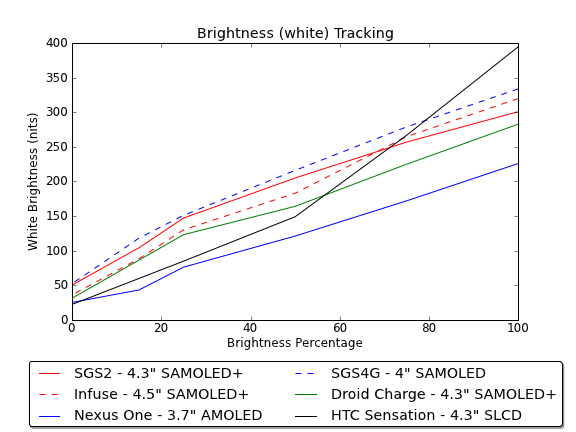
It’s redundant to show black brightness since each device measures 0 nits due to black pixels not emitting any light, so AMOLED remains super contrasty, even if brightness is about the same with SAMOLED+ as it was with SAMOLED. Thankfully the curve is nice and linear.
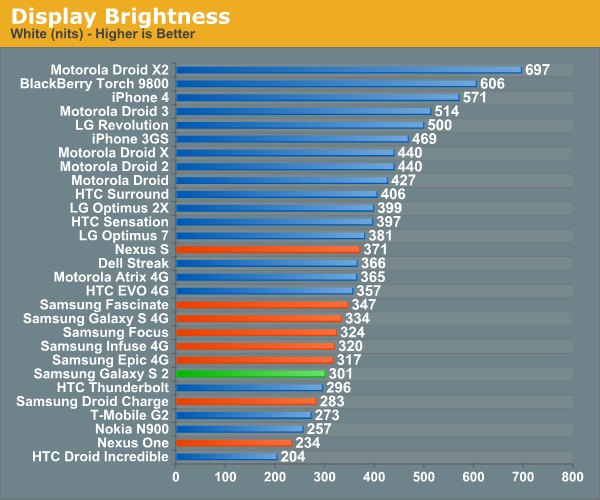
On the big display graph though, SAMOLED+ still isn’t as bright as the competition, though again having infinite contrast does make the display subjectively awesome indoors.
Outdoors SAMOLED+ is about the same as the previous generation. It isn’t very easy to see the display contents outside in direct sunlight, but then again what phone does look as good outside as it does inside? SAMOLED+ as mentioned earlier still leverages the optical bonding benefits (fewer reflections) that SAMOLED brought, so if you were pleased with view-ability there expect much of the same with this update.
The only major issue outdoors is something else entirely. I noticed pretty quickly with the Infuse 4G and Droid Charge that outside in my climate’s environment (~100+F outdoor temps, lots of sunlight) that the phones would clamp brightness to about 75% to prevent overheating. This is in part a measure to protect the display panel and of course other internal components. I set out to find out whether SGS2 implements the same thermal restrictions, and it does.
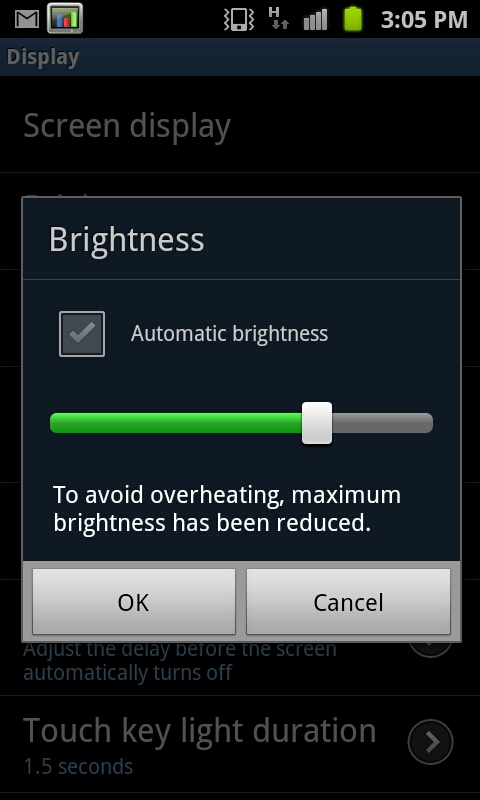
I broke out my contactless IR thermometer and went outside into the midday sun on my patio and set the phone down. Overheating and clamping down the display brightness doesn’t take long in this climate, about 5–10 minutes will do it. At around 115F (~45C) surface display temperature you’ll get clamped to 75% maximum until temperature drops down. I actually subjectively don’t think SGS2 is as prone to overheating as the Charge or Infuse.
Some other people have reported SGS2 crashing or encountering a thermal shutoff after a certain point, so I braved the heat and stayed outside even longer using the device until it hit well over 140F (60C) and still no system shutdown or overheating happened. That’s not to say it isn’t possible, as the SGS2 clearly does have thermal monitoring, for example the following lines from dmesg suggest some thermal monitoring going on, though I definitely crossed these boundaries to no ill effects:
<6>[ 0.047638] thr_low: 83, thr_high: 98 warn_low: 97 c warn_high 106 <6>[ 0.047715] tq0_signal_handle_init <6>[ 0.047751] tmu_initialize: te_temp = 0x00000048, low 8bit = 72,high 24 bit = 0 <6>[ 0.047765] Compensated Threshold: 0x7d <6>[ 0.098087] Cooling: 82c THD_TEMP:0x80: TRIG_LEV0: 0x89TRIG_LEV1: 0x99 TRIG_LEV2: 0xa0
Back to the display, next up are viewing angles, which the SGS2 thankfully preserves from the previous generation. I tossed the SGS2, SGS4G, and Optimus 2X in the lightbox and took pictures at various extreme angles. I realize the Sensation is a comparison point people are interested in, unfortunately that went back a while ago.
Viewing angles are awesome on all three - the SGS4G’s SAMOLED display (left), SGS2’s SAMOLED+ (middle), and Optimus 2X’s IPS display (right).
Another small thing about the SGS2’s SAMOLED+ is that I’ve noticed that high contrast images can be persistent for a few seconds. It isn’t burn-in, but a persistence that stays for a few seconds and can be very visible. For example, leaving the Android keyboard up (which is black, grey, and white) and dragging the shade down, a shadow of the keyboard remains visible until it fades after a few seconds. This persists even on other applications as well, and I can only hope doesn’t become something permanent if left up too long.
Wrapping up SAMOLED+ is difficult, because whether or not you like it over traditional LCD alternatives is ultimately a very subjective (and as I’ve learned in discussions, sensitive) matter. We’ve codified the differences between SAMOLED+ and previous generations, and other IPS displays, but really it’s impossible to communicate every subtle difference.
Personally, I prefer higher PPI IPS-LCD displays, though at 4.3“ SAMOLED+’s WVGA (800x480) isn’t a slouch, and the change from RGBG PenTile to an RGB stripe helps matters. Where WVGA starts to become a problem is at 4.5”. Scaling up area and increasing the diagonal size by 0.2“ doesn’t sound like a problem, but r^2 is a bitch, and at that size both the Android UI elements and subpixels look absurdly huge. Luckily, the international SGS2’s 4.3” is completely tolerable with WVGA.
MHL
Last but not least, the SGS2 supports HDMI out through USB MHL. For those that haven’t encountered the term before, MHL (Mobile High definition Link) is just a way of getting HDMI out through a low pin-count port alongside supplying power. So far, all MHL I’ve seen has worked over microUSB, but other interfaces possibly may support MHL in the future as well.
I had a Samsung MHL adapter laying around from a Samsung Infuse 4G, which has a microUSB port on the side for connecting to a charger, a full size HDMI port, and the microUSB connector which plugs into the host device. With all this connected, you can then get HDMI mirroring working, which does work on the SGS2.
I connected the SGS2 over HDMI up to an ASUS PA246Q and saw it negotiate a 1080i link and do HDMI mirroring flawlessly. Landscape is also supported, thankfully, and seems to work just like it should.


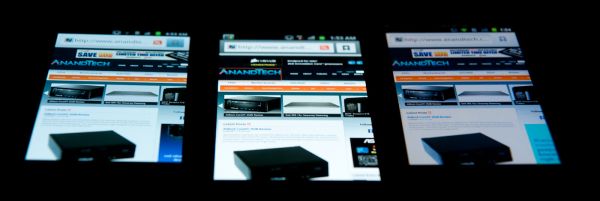






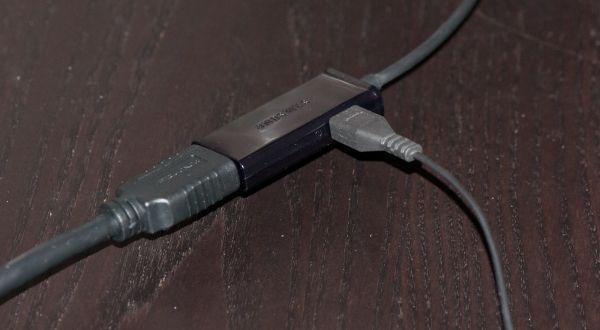
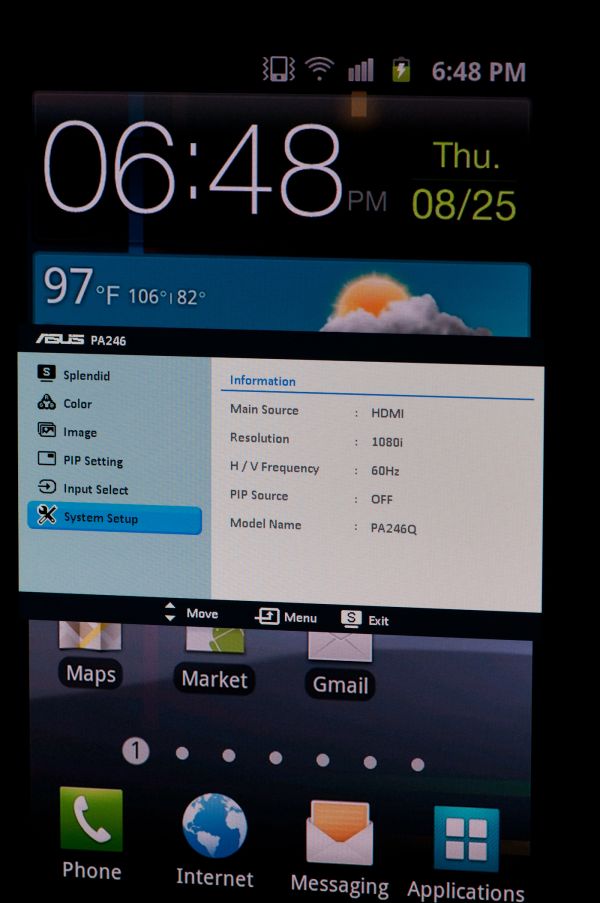








132 Comments
View All Comments
VivekGowri - Sunday, September 11, 2011 - link
I literally cannot wait to read this article, and I similarly cannot wait for SGS2 to launch in the US.ImSpartacus - Sunday, September 11, 2011 - link
You guys don't get early access to drafts?niva - Monday, September 12, 2011 - link
I own an original Galaxy S, until it's been proven that Samsung updates to the latest Android within a month after major releases I will not buy anything but a Nexus phone in the future (assuming I even go with Android). By the time that decision has to be made I'm optimistic there will be unlocked WP7 Nokias available.Havor - Monday, September 12, 2011 - link
Seriously , whats the problem, I was running 2.2 and 2.3 when they came out, could have them sooner, I just dont like to run roms with beta builds.So you never heard of Rooting and Custom Roms?
Its the nature of companies to have long and COSTLY eternal testing routs, done mainly by people with 9 to 5 jobs, as delivering buggy roms is bad for there name, but then so is not updating to but its lots less hurtful, as most people dont care or know any better.
Next to that if your phone is a phone is customized with extra crapeware by your provider it can be that it takes months before you get a update even do Samsung delivered one a long time ago.
The rooting scene is totally different, its done by nerds with passion for what they do, and yes the early/daily builds have bugs but also get mouths quicker reported and fixed by the scene.
And imho are the final updates just as stable as the factory builds.
Dont like how your Android is working?
Stop bitching and fixed your self, its not that hard, as it is a OS platform, just make sure you can root your phone, before you buy it.
The following website explains it all.
http://androidforums.com/galaxy-s-all-things-root/...
http://androidforums.com/galaxy-s-all-things-root/
vision33r - Monday, September 12, 2011 - link
If it's your personal phone, you can do whatever you want. However like some of us here with jobs that let us pick phones. One requirement is the phone has to be stock and no rooting allowed.Samsung is about the worst of the 3 makers in terms of software updates.
niva - Monday, September 12, 2011 - link
Seriously calm down, I've heard plenty about rooting and custom roms but phone hackery is not something I'm interested in right now. I don't have the time or energy for it. I shouldn't have to manually go through rooting and updating my phone, especially when security issues are involved.I like the way 2.2 is working on the SGS. I bought this phone from a friend who upgraded and it's not something I would've paid the retail price for. I've not run into anything so far that's made me actually bother with the rooting and manual upgrade process. I've not read into rooting the phone or updating it, but I'm sure if I get into it this will take me a long time (hours/days) which I shouldn't need to sacrifice to run the latest version of the OS.
From the political standpoint the blame is both on Samsung and T-Mobile apparently in terms of getting the new revisions out.
From my personal standpoint I despise all companies who do not use the default Android distro, running skins and secondary apps, on the phones they ship out. While some of the things they do are nice, it slows down their ability to keep up with android revisions.
On the other hand, my wife's Nexus (original one) updates faster than internet posts saying Android 2.3.x has been rolled out. It's friggin awesome. She had one problem with battery draining really fast after a recent upgrade but I managed to fix that after a couple of hours of forum searching and trying different things.
So it's simple, if I will buy another Android in the future, it will be a Nexus phone, where I know from personal experience that everything works in terms of having the latest and greatest. Notice the Nexus S is made by Samsung, it's for the most part identical to the phone I have, yet gets the updates immediately and doesn't have the known security problems I'm exposed to.
ssj4Gogeta - Monday, September 12, 2011 - link
Well, the international version got 2.3.3 around ~3 months ago here (and earlier for other countries).poohbear - Tuesday, September 13, 2011 - link
vision33r u dont know what you're talking about. People bitch and complaina bout software updates, but how are the quality of those updates? when its updated too soon there are bugs and ppl complain, updated later ppl complain about the wait times. I remember last year Motorola said they're not updating their XT720 to android 2.2., they're leaving it at 2.1. S korea Motorola was the only branch that decided to do it, but guess what? 2.2 was too much for the hardware in the XT720 to handle, and it ran slooooow! XT720 users all over complained about it, but the reality is the phone couldnt handle it. 90% of smartphone users want something stable that works, they dont care about having the latest and greatest Android build. So if Samsung errs on the side of quality and takes more time to release stable quality software, then all the power to them!anishannayya - Friday, September 23, 2011 - link
Actually, if updates are your hard-on, then you'd likely be looking at Motorola in the future (due to the Google acquisition).The entire reason why the Nexus lines of phones are quick to get updates is because the are co-developed with Google. As a result, these phones are the ones the Google developers are using to test the OS. When it is ready to go, it is bug free on the device, so Samsung/HTC can roll it out immediately.
At the end of the day, any locked phone is plagued by carrier bloatware, which is the biggest slowdown in software release. Just buy an unlocked phone, like this one, in the future.
ph00ny - Sunday, September 11, 2011 - link
It's awesome to see this article finallyI'm glad François Simond aka supercurio contributed to the article
Btw that slot on the left is for the hand strap which is very popular in asia for accessory attachments